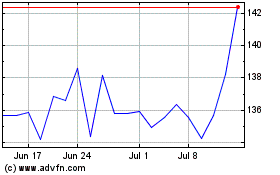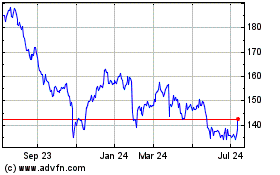UPS Gets Boost From Efficiency Drive -- WSJ
April 29 2016 - 3:03AM
Dow Jones News
By Laura Stevens
United Parcel Service Inc. reported 10% growth in quarterly
income, helped by efforts to boost efficiency and lessen its costs
delivering online orders to U.S. homes.
Residential deliveries, up more than 6% in the quarter, are
inherently more costly than shipments to businesses because the
packages tend to require more driving and time. UPS has invested in
software to improve delivery routes, added package pickup locations
to pool deliveries, and is doing more so-called last-mile
deliveries instead of paying the U.S. Postal Service for that
service.
"We're creating that density that allows for the improvement in
the economics," Chief Financial Officer Richard Peretz said in an
interview. "You're really starting to see that benefit in the last
few quarters."
The company said it expects its momentum to continue, and it
backed its full-year guidance. But it also said a decision by the
U.S. Treasury Department regarding pension cuts may trigger a
charge of up to $3.8 billion this year that would push earnings to
the lower end of its forecast range.
Shares were down less than 1% to $106.35 in recent trading on
the New York Stock Exchange.
For its quarter ended March 31, the Atlanta-based company's
revenue rose 3.2% to $14.42 billion. UPS earned $1.13 billion for
the period, up from $1.03 billion the same quarter a year
earlier.
The company increased U.S. domestic package operating profit by
7.6% to $1.1 billion and expanded its operating margins as the
company reduced its average cost per package by 1.9% through
efficiency gains and lower fuel costs. Average daily U.S. package
volume increased by nearly 3%.
For the first time, executives outlined potential costs related
to the pension fund of some of its current and former employees.
The Central States Pension Fund, as it is called, has asked the
Treasury Department for approval to cut benefits, and a decision is
expected by May 7. If the cuts are approved, the company said it
may need to pay between $3.2 billion and $3.8 billion to cover
about 48,000 current and former Teamster employees in the fund.
UPS executives said the company would fight such an outcome,
because it believes the fund's plan as submitted is illegal.
Congress in 2014 passed a new law to allow pension plans to avoid
insolvency through measures including suspending or reducing
benefits. Under that law, UPS said its group of affected employees
is supposed to be the last to receive cuts, but are instead
disproportionately targeted.
The company paid $6.1 billion to exit the Central States plan in
2007, establishing a new single-employer plan for employees and
eliminating its contribution requirements to the multiemployer
plan. UPS committed at the time to make up the difference for
employees moved from the old plan into the new plan if the Central
States plan's benefits were reduced.
--Anne Steele contributed to this article.
Write to Laura Stevens at laura.stevens@wsj.com
(END) Dow Jones Newswires
April 29, 2016 02:48 ET (06:48 GMT)
Copyright (c) 2016 Dow Jones & Company, Inc.
United Parcel Service (NYSE:UPS)
Historical Stock Chart
From Mar 2024 to Apr 2024

United Parcel Service (NYSE:UPS)
Historical Stock Chart
From Apr 2023 to Apr 2024
